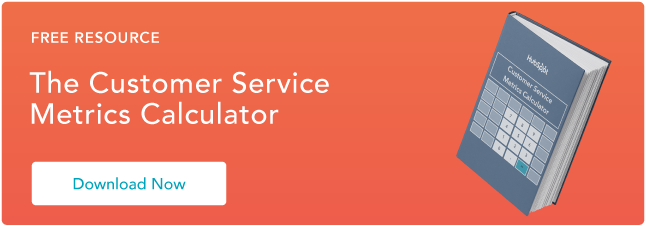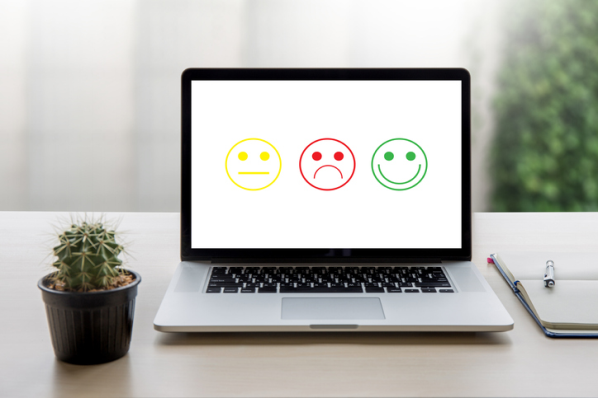Net Promoter Score Examples
Net Promoter Score is a customer loyalty metric that measures how likely a customer is to recommend a product or service to a friend.
NPS, or Net Promoter Score, is a simple metric to get. All you have to do is ask customers: "On a scale of 1–10, how likely are you to recommend this product?" Anyone who scores a 9 or 10 is a "promoter." Your NPS is calculated by subtracting the number of detractors from the number of promoters and dividing by the total number of respondents.
At HubSpot, we use NPS to measure the customer experience with our support teams. Here are two examples of NPS scores from our team and how they are used to improve our customer service.
Example #1

This NPS score is from a support case that was filed on behalf of a customer who needed help with designing a web page. Due to the structure of our support team at the time of the request, we, unfortunately, didn't have the bandwidth to meet this customer's expectations. We know we fell short because the customer stated they were "left feeling disappointed" from the interaction.
That's certainly not what we like to hear, but an opportunity presented itself from this feedback. This NPS score opened a channel for ongoing communication between our team and the customer.
We now know exactly where we failed to meet the customer's needs, which allowed us to follow up with the customer to see if we could provide any additional support. Our product development teams now know that some customers benefit from an advanced design support team. By including an NPS score at the conclusion of support cases, our teams can solve for our customers using both short and long term solutions.
Example #2
Here's a Net Promoter Score we're a bit prouder of. When asked about our workflows tools, our rep not only provided an appropriate and effective HubSpot Academy article, but he also gave some thoughtful advice on how to best apply the resource. The customer is happy, we're happy. Call it a day, right?
Wrong. We can still use this feedback to improve our customer experience. From this NPS score, we learned which product documentation is useful for our customers. We can now analyze that resource and replicate its layout in future pieces of content. We also learned an effective way of communicating this content to the customer. In customer support, language and phrasing are crucial, so we can use this ticket as a reference for other support reps who may encounter a similar case.
To help provide some clarity, we'd like to introduce you to five companies using NPS data in very interesting ways. Check them out below:
How to Use Net Promoter Score Results
1. Polish Interactions with Prospects and Customers.
Tracking how likely your customers are to recommend you is the first step towards a customer-driven culture committed to improvement, constant improvement. Because NPS doesn't stand still it shifts in response to your actions or inaction; it moves with trends and competitors.
No one understands this better than Bill Macaitis, CMO of Slack, former CMO of Zendesk, and former SVP of Online Marketing and Operations at Salesforce. It's basically his job to create marketing teams for the fastest growing companies on the planet ... and NPS is a central part of his method.
In an interview with Tomasz Tunguz in SaaS Office Hours, Macaitis answered the question, "Which marketing metrics are most important?" with:
"One metric that most SaaS marketers don't measure frequently, but should, is Net Promoter Score. NPS measures the likelihood of customers to recommend the product. Best in class companies achieve a score of 70 on a scale of 100, but according to Zendesk data, the typical B2B software company achieves only 29.
NPS is a leading indicator of future growth. The larger the number of advocates for the product, the lower the customer acquisition costs for the company, and the more effective customer success team will be."
Company Example: Slack
If you've been living in a cave you may not know that Slack is on fire. The company has been setting record highs for growth, gaining a $1 billion valuation in just a year. How? Through word-of-mouth marketing tracked by NPS.
In a live AMA, Macaitis summed it up like this:
"Every CEO should be able to answer this question: What are the top 3 reasons why people recommend and do not recommend your brand?"
Macaitis uses NPS to polish every interaction prospects and customers have with Slack, taking a holistic view of UX that includes not just customer service and sales, but things like online ads and their legal terms of service.
He says he's not satisfied by prospects signing up for Slack or becoming paying customers — the bar is set at whether they recommend it.
2. Create and Develop New Products.
NPS data is valuable to more than just your customer service team. For example, product development would be interested in hearing what customers have to say about specific features and updates. They could use this information to repair a broken product or for inspiration when creating a new version of your product.
This is where it's important to have a help desk that categorizes support tickets as well as feedback responses. You can also sort responses by different keywords related to your products and bucket these scores into one file or category. Then, product development would have an active list of qualitative responses to monitor when new products are launched or if product failures occur.
Company Example: Magoosh
Magoosh, an online test prep company for the GRE, GMAT, TOEFL and SAT exams, also considers NPS to be among the most important metrics they track. They understand better than most that in order for their service to be successful, their customers have to be successful and achieve their goals outside of their product. As Peter Poer writes on Magoosh's blog:
"It helps us determine not only whether students like our customer service and user interface, but also how well our products prepare students for their exams. And most importantly it has been a reliable leading indicator of growth in word-of-mouth referrals – our largest marketing channel."
Magoosh's NPS is inextricably tied to how well their customers perform on their real-world exams. This means that instead of asking the NPS question after purchasing their product, as most companies do, Magoosh had to wait until after the student took their exams and saw their final scores (which often aren't sent out for weeks after exams take place).
Poer went on to explain:
"The proof is in the pudding. You can't fully decide if you're willing to recommend Magoosh for GRE prep until you've taken the real GRE."
So, when Magoosh noticed that their NPS sank for their GMAT product, it was a red flag that something was very wrong. That dip in their NPS led them to discover that students were complaining that the scores they had on their Magoosh practice tests didn't match up with their real scores in the GMAT. Poer also spoke to this in his article:
"Our algorithm was telling students to expect one score, but, for some, their official reports were coming back lower — obviously a frustrating experience.
We determined that we needed to fix our score prediction algorithm to be more accurate, but we were left with a major concern: would an improved algorithm that displayed a lower predicted score be demoralizing for students? Which was worse for customer satisfaction — a lower predicted score while studying, or a disappointing final score after the exam?"
Magoosh had three problems:
- They needed to make a change
- That change could result in an even worse NPS
- They wouldn't know for months, because of testing and results dates
Making a significant change that could tank their word of mouth marketing, and not knowing for months if it worked, was too great a risk. So, Magoosh modified their NPS gathering technique to deliver faster answers while students were still studying. They used an NPS tool called Wootric to ask the NPS question within their own product. They were then able to A/B test their algorithm change with half of their GMAT students and track their "likely to refer" rating at the same time.
The change in algorithm didn't end up demoralizing students, and when the change was implemented for all GMAT test-takers, their post-exam NPS scores improved dramatically.
3. Reduce Potential Churn.
Customer retention is important because retaining customers is significantly cheaper than acquiring new ones. If you sell an out-of-the-box product, you want customers to think of you if they need to buy a similar one in the future. If you're a SaaS or subscription-based business, you want customers to renew their subscription and to continue work with your brand.
Net Promoter Scores are like an alert system for potential churn. When a customer is upset, they can leave negative feedback via your NPS survey. If this survey is synced with your CRM, account managers and CSMs can be notified about the unhappy customer and reach out to reconcile the issue before churn occurs. Remember, only one out of 26 unhappy customers will leave a negative review, making it extremely important to reach out to these customers who've taken the time to express their displeasure.

Even though every customer won't tell you why they're unhappy, reviewing the NPS feedback from the ones who do will help you prevent churn altogether. Research shows that one in three customers will leave your company after just one poor experience, and 91% will leave after two or three. So, it's important to learn from your mistakes quickly if you want to keep your customers around.
Company Name: Entelo
As a recruiting analytics software company, Entelo's purpose is to help their customers achieve their recruiting goals. To do so, they have a designated Customer Success team, directed by Loni Spratt, who keeps careful tabs on NPS.
They field issues that improve customer experience every day, whether it's a big change like improving their products, or small changes that help customers see more value. But, since one of the team's main tasks is to reduce churn, monitoring customer satisfaction and reacting quickly to complaints is of primary importance.
When Spratt first joined the company, Entelo was collecting NPS data as part of a bi-annual survey, making it nearly impossible to track how customers were doing in real-time. Serious customer satisfaction issues could go unidentified and unaddressed for months — and that's when customers bothered to respond to the survey at all.
Spratt now uses an in-app NPS tool to present the NPS question to their customers, which means customers can share their thoughts (or frustrations) instantly, as they experience them. More importantly, Spratt's team can respond to any issues the same day. As Spratt said in a case study interview:
"Some of our customers are actually shocked at how fast we react when a negative comment comes in. We've definitely received comments of, "Whoa. I just did this an hour ago. Is this an automated thing?" They think it's really cool."
Spratt's customer success team can now predict with greater accuracy which customers are most at risk of churning, and can take action to prevent the churn from happening. But that isn't the only benefit they've experienced from tracking NPS so closely.
Entelo's sales department has also been getting in on the action by tracking which customers give high scores. They've found that these customers are more likely to be profitable targets for cross-sells and upsells. The marketing team appreciates the data too — they can identify their most satisfied customers for future case studies and use cases.
4. Communicate With Customers.
Feedback is an opportunity to communicate with your customer base. Whenever a customer submits a review, they're showing genuine interest in your company. Even if their comments are completely negative, the core purpose of their message is to improve your business.
When you're sorting through NPS responses, be sure to respond to both promoters and detractors. These two types of scores represent two completely different customer experiences, so you should approach each group with a different follow-up plan.
For promoters, tell them that you appreciate their feedback and make sure there's nothing else you can do for them before you close their case. For detractors, try to determine how you can correct the problem and let the customer know that you're sorry for the inconvenience. It's important to work quickly with detractors before the customer looks to a competitor.
Company Example: HomeBase
When John Waldmann, founder of Homebase, employee scheduling software, realized that the personal, individual approach he preferred to take with his customers wouldn't scale with his quickly-growing company, he searched for the next best thing: adopting NPS early to track customer feedback. His advice to other business owners is to "turn NPS on sooner than you think you need to."
He uses NPS in a unique way, as a channel for open, constant communication between him and his users:
"The original intent with Net Promoter Score was to give us a more quantitative view of how are we doing on the product, but it's actually become a new channel of communication and feedback from users that we wouldn't have received otherwise."
Homebase serves two segments of users — business owners, and their employees. In other words, those who create schedules, and those who receive them.
For his customers to be successful, both sides of that equation have to be happy with his software, which requires a careful balancing act to not skew UX towards one side or the other.
To keep on top of making both sides happy, Homebase has built NPS surveys into their software as an integral part, and Waldmann delivers that NPS feedback to his team every week to alert them to issues that may arise and to keep product development focused and on target.
5. Demonstrate Your Dedication to Customer Success.
Your customers should know that you're deeply invested in their success. NPS helps your company demonstrate this investment by proactively asking for customer feedback which shows that you really care about improving their future experience.
The best way to demonstrate this investment is by following through on customer requests. If multiple customers are expressing their displeasure with a product or service, investigate the issue, and provide them with a clear resolution. Don't make promises you can't keep, and be transparent when you make mistakes. Customers appreciate sincerity because it shows that you have their best interest at heart.
Example Company: USAA
USAA embraces this concept as it's one of the top performing companies ranked by NPS. Additionally, all three of their service offers (banking, insurance, credit cards) were ranked in the top ten for their distinctive product categories. This significantly benefits the company because USAA can show these rankings to their customers as a means to build credibility.
USAA also uses an internal NPS to develop their products and services. They created the Innovation Community for Enterprise which encourages their employees to submit new ideas. This allows them to overcome data silos and gain perspective from departments that aren't typically involved in the process.
In an interview, Lea Sims, USAA's VP of Employee Innovation, said the initiative gives employees the tools needed to be innovators because "innovation is everyone's job." This creates a win-win for USAA as it not only educates their employees, but it motivates them to create a better customer experience. USAA can then communicate that to their customers to show how their entire company is working towards customer success.
Net Promoter Score Best Practices
NPS can provide highly valuable insight into your customer's needs as well as the roadblocks preventing you from meeting their needs. It's important that you get the most out of this feedback by effectively analyzing it. Here are some best practices to consider when implementing NPS on your teams.
1. Choose the best point of communication.
Getting customer feedback can be a lot harder than it sounds. Customers are busy, and they aren't always interested in taking the time to leave comments.
To avoid this, make sure you're presenting the NPS survey at a logical point in the customer experience. Think about when roadblocks could occur, then input the NPS survey to determine if the solutions you're providing are actually working. If timed right, customers should be eager to tell how they feel about your company.
Company Example: MasterClass

MasterClass triggers an NPS survey after a user completes one of its courses. This is ideal timing because the class will be fresh in the user's mind, so they'll provide a live reaction to whether or not the course curriculum was useful or not. If MasterClass waited until the customer returned for the next class, they might not remember everything about the previous course.
2. Follow up on your detractors.
When a customer leaves a poor score, it's an opportunity for your company to learn more about that customer. Follow up with that customer and start a dialogue about what went wrong with their customer experience. This not only demonstrates a clear dedication to customer success, but it helps your employees understand their target audience. They can get to know them on a personal level and have a better idea of what your customers want from your business.
Company Example: Groove

This feedback response from a Groove customer service rep starts a productive conversation with the customer. She aligns with the customer's painpoint then offers a personalized solution to resolve the issue.
But, the rep doesn't force the premium offer, either. She asks if she can set it up for them, creating an opportunity to have a conversation with the customer about their experience. This makes her offer seem more sincere and less like a bribe to make up for the company's mistake.
3. Don't neglect your promoters.
When you get a good NPS score, it's easy to just celebrate and move on. However, these scores represent more than just a pat on the back. They can be used to promote your business as a customer-centric company. Reach out to these customers, thank them for their review, and see if they would be willing to provide you with a customer referral.
Company Example: Baremetrics

Here's an example from Baremetrics of a customer service rep thanking a promoter for leaving an NPS. The rep then kindly asks the customer to spread the word about the company and even provides a pre-written Tweet that the customer can simply copy and paste to their account. This is a great way to build stronger relationships with your loyal customers as well as leverage their experiences for customer advocacy.
4. Integrate NPS into your customer service analytics.
Since NPS provides you with a numerical score as well as a qualitative description, it's easy to integrate NPS into your current analytics system. You can organize and sort scores based on the descriptive comment, then use this information to identify patterns in consumer behavior. Using NPS along with internal resources like product usage reports can help your team understand why customers use specific tools or products while neglecting others.
Company Example: HubSpot

Here's an example of an NPS analytics dashboard setup through HubSpot Service Hub. It tells you how many people have viewed and completed the survey as well as what percentage of those responses are promoters vs. detractors. Having a live breakdown like this provides management with an overall view of NPS at the company-level, not just at the individual-level.
5. Use NPS with other feedback tools.
While NPS is an effective means to obtain customer feedback, it shouldn't be your only way to measure customer satisfaction. Some customers may be confused by the survey, or give you unclear descriptions of their problems. They may omit details that are vital to the scenario and create an inaccurate depiction of their experience.
It's not the customer's responsibility to provide clear or accurate feedback — it's your team's responsibility to fully assess each promoter and detractor score. By using NPS alongside other feedback tools, you can develop a more complete picture of the customer's experience.
Company Example: Hotjar

Hotjar uses this nifty survey when it wants to obtain more qualitative feedback from their customers. Instead of asking users whether they'd recommend the product, they ask them what the company can do to "wow" them in the future. This provides the customer service team — and the company as a whole — with actionable feedback for how they can improve user experience.
Net Promoter Score: A Simple Solution to a Complicated Problem
NPS is very simple, but that one question can be used in a multitude of ways by companies of any size to improve customer experience, reduce churn, and increase the number of delighted customers who become brand advocates.
Huge companies like Airbnb and Amazon use NPS. Quickly growing companies like Slack and Unbounce use NPS. Even small companies like Homebase and Entelo use NPS. And, of course, Hubspot uses NPS.
In Satmetrix Consumer Net Promoter Benchmarks, which ranks industries by average NPS, the "software and apps" segment ranks low — just above health insurance, cable, and internet service providers. Clearly, most software companies are leaving their users unsatisfied, likely focusing on acquisition goals instead of retention.
Consider this not as a warning, but as an opportunity. We may work within a crowded marketplace, but by using NPS, we have a chance to set ourselves apart.
Net Promoter, Net Promoter System, Net Promoter Score, NPS and the NPS-related emoticons are registered trademarks of Bain & Company, Inc., Fred Reichheld and Satmetrix Systems, Inc.
NPS
.png?width=112&height=112&name=Image%20Hackathon%20%E2%80%93%20Vertical%20(85).png)


![How I calculate net promoter score [formula & examples]](https://53.fs1.hubspotusercontent-na1.net/hubfs/53/%5BUse-Oct-14-2025-10-16-33-2257-PM.webp)



.jpg)



![NPS Question: The Secret to Getting It Right [+ 5 Best Practices]](https://53.fs1.hubspotusercontent-na1.net/hubfs/53/nps%20question_featured-1.jpg)
